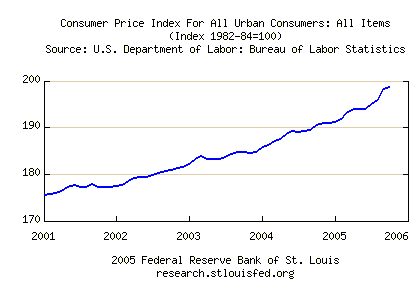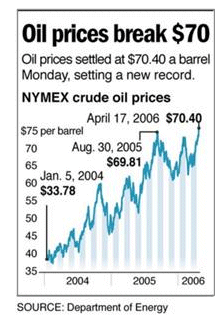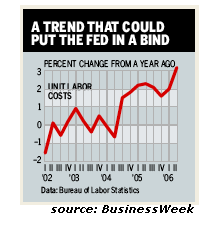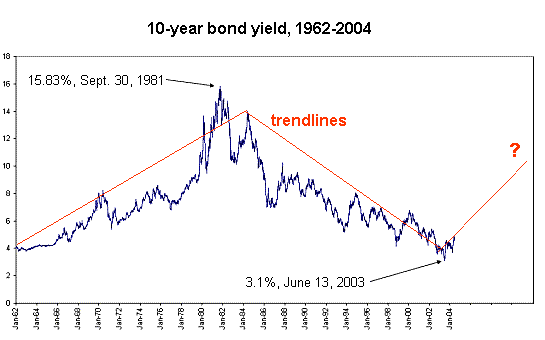

|
| weblog/wEssays archives | home | |
|
Protecting Capital II: Inflation and Bonds (September 6, 2006) Today's topic: those making the right call on inflation (and therefore interest rates and bonds) will prosper, those who guess wrong will not. There are roughly three camps in this debate: 1) the "standard Line" on Wall Street is that inflation is benign due to "global wage arbitrage" (i.e. everything on the shelves here is made elsewhere by incredibly cheap labor), and will stay benign, creating the Goldilocks economy, "not too hot, not too cold." 2) Commentators like our esteemed blog colleague Mish cite evidence that the U.S. is headed down a deflationary, Japan-like path of falling prices for both goods and assets, an environment in which interest rates are low but nobody is borrowing because they're tapped out or can no longer qualify. This typifies an era following a debt bubble. 3) Inflation has been masked by official legerdemaine, but beneath the phony statistics it is real. The chief cause is the global expansion of trade and capitalism to those once-dormant giants, China and India. Their insatiable demand for commodities of all kinds is creating demand which outstrips supply, leading to higher prices and inflation. On top of that, the huge expansion of the U.S. money supply has fundamentally eroded the value of the dollar, whose depreciation leads to higher import prices and thus inflation. 
So which one is right? I would hazard "none" and "some of all." I suspect the future will not be quite so clean-cut; perhaps assets will suffer deflationary pressure (simply put, supply will far outstrip demand for all classes of assets except precious metals and certain commodities like grain), even as the costs of non-discretionary goods and services rises inexorably, feeding inflation. Wall Street's happy story of ever-rising assets and benign inflation has it exactly backwards: financial assets (stocks and bonds) and real estate assets will suffer a long, seemingly endless decline, while essential goods and services will continue rising even as the economy slumps. This was called "stagflation" in the 70s, and while the present may appear to be similar to that era, the underlying causes are quite different. Here's something I haven't read anywhere else: a variety of goods and services are lumped together in calculating the official rate of inflation, but there are two different forces at work. As Mish has recently pointed out, discretionary items such as restaurant meals and nail manicures are dropping in price, evidence of deflationary forces as work. As the consumer spending slumps (as the housing bubble-borrowing frenzy-"wealth effect" evaporates) then non-discretionary businesses lose their pricing power. To attract scarce customers, they drop their prices. But the costs of essential (non-discretionary) goods and services are rising rapidly. Need a list? How about housing? If you rent, rents are rising. If you own, property taxes are going through the roof, as is your insurance (remember it now costs twice as much to rebuild your abode.) How about food? Never mind what the official hocus-pocus claims; you know food has risen by more than 3% a year. And no wonder; U.S. agriculture and its distribution system is heavily mechanized, which means it burns vast quantities of oil to grow the food, package it and then deliver it thousands of miles. Do you really think oil can rise from $25 to $70 with absolutely no affect on agricultural industry costs? 
Yes, let's not forget energy. A tripling in the cost of oil in a few years has magically been discounted by official numbers, but consumers are most assuredly paying considerably more for electricity, heating and transportation. Yikes! I almost forgot the rising cost of debt. All those millions of option ARM and 3/1 ARMs (adjustable rate mortgages) re-sets are going to put the pinch on millions of households. Do you reckon the lenders care whether inflation is high or low? Ha. Those mortgages are going to re-set at much higher rates regardless of the official rate of inflation or even the current mortgage rates. Next up: education. Have you checked out the tuition, fees and housing costs recently for universities, even the state institutions? My own alma mater, The University of Hawaii, just jacked up tuition by a $1,000, from $3,500 to $4,500. The cost of higher education has been rising by leaps and bounds. My brother-in-law is a professor at UH, and so I can relate the story of labor costs in that system--costs which are not unique to Hawaii. Briefly: the recession of the early 90s forced the state to tighten its belt, and one way to do so was trim state wage increases to 2% (less than inflation). This belt-tightening lasted all through the 90s, and naturally organized labor got tired of earning less every year while the economy boomed. So labor contracts throughout the U.S. were renegotiated around 1999-2000 with fat increases to compensate for the lean years. These costs are just now becoming apparent. For example, the U.H. contract stipulated the usual 2% raises (again, effectively dropping inflation-adjusted wages) for five years, with a balloon raise of 25% on the 6th year. Well guess what--that 6th year has finally arrived, and the state has to pay up. This is not an isolated instance; our city library system reports that fully 40% of its budget this year is going toward the library workers retirement funding. Let's not forget the cost of benefits, which have been rising at a double-digit pace as well. Last but not least, how about the sector which accounts for 16% of the entire U.S. economy: healthcare. Do you really believe costs have stayed flat in healthcare? Just look at your statements--not what you pay, but what your insurance (assming you're fortunate enough to have some) or Medicare paid the provider. Costs have been leaping by double-digit amounts for years, yet "official" inflation numbers don't reflect this reality. Why? Because they under-report that 16% of the economy as a mere 5% of household expenses. So we only spend 5% of all our national income on healthcare, yet it makes up 16% of the GDP. Go figure that one out. 
Lest you think I exaggerate this rising-wages trend, allow me to quote BusinessWeek (Sept. 11 issue): Perhaps the most important revision to last quarter's GDP numbers was a sharp upward refiguring of workers' income from wages, salaries, and benefits in both the first and second quarters. The BEA now says overall compensation last quarter, originally up 6.8% from a year ago, has grown 8.3%. That increase is double the rate of inflation and close to the booming pace seen in 2000.Don't you wonder how wages can rise over 8% and inflation remains at 3%? Something doesn't add up. Inflation is rising much faster, and in a much more pervasive manner, than official statistics suggest. For example: Economists watch for creeping inflation. How can wages rise as the economy slips toward recession? "Baumol's disease." To quote from my June 5th entry Could We Have Both Deflation and Inflation At the Same Time?: "Baumol's disease" is an economic term which describes how service labor costs rise regardless of recession or global forces on production costs. If you think about it, it makes perfect sense. The vast majority of the U.S. economy and workforce is service-related--there are 8 million more government workers (22 million) than there are manufacturing employees (14 million), and 76 million "service workers". Net result: even if the price of TVs and particle-board shelving drop to near zero, the majority of household expenses remain service or debt-related.To put it simply: the non-discretionary part of household expenses (housing, taxes, medical and healthcare, energy/transportation, etc.) eats up most of the family income. The sliver left for fast food meals, nail manicures or particle board shelving from Ikea-- goods and services which could drop in price--is small. Therefore, the inflationary forces in non-discretionary spending will overwhelm the deflationary forces at work in the discretionary arena. So if inflation is real, growing and pervasive, what happens to interest rates? They have to go up, unless the Fed decides to let inflation ramp up to 5% or more--something it states it won't permit. And what happens to bond rates when interest rates rise? They rise, too, don't they? So why would anyone buy a 10-year or 30-year bond if they think bond rates will only rise in the future? They wouldn't, because every 10% rise in the bond yield will drop the value of their bond by 10%. 
The standard Wall Street line is that "if" the economy weakens (not that it will, of course!), then the Fed will quickly drop rates to re-inflate housing and consumer credit-card spending. Nice theory, but what if inflation is real and rising? How can the Fed lower rates without triggering runaway inflation? Perhaps the more likely scenario is a reversion to the historical pattern revealed in this chart: an approximately 20-year cycle of rising and falling bond yields: rising from 1962 through 1982, and then falling from 1982 through 2003. Now they are rising again, and given inflation's pervasiveness, it is certainly plausible that we have started another 20-year upleg in bond yields. Think rates are going to drop dramatically? Don't bet the ranch on it. For more on this subject and a wide array of other topics, please visit my weblog. copyright © 2006 Charles Hugh Smith. All rights reserved in all media. I would be honored if you linked this wEssay to your site, or printed a copy for your own use. |
||
| weblog/wEssays | home |